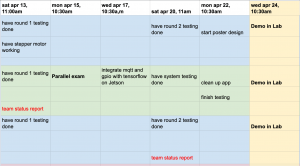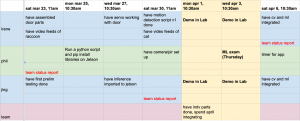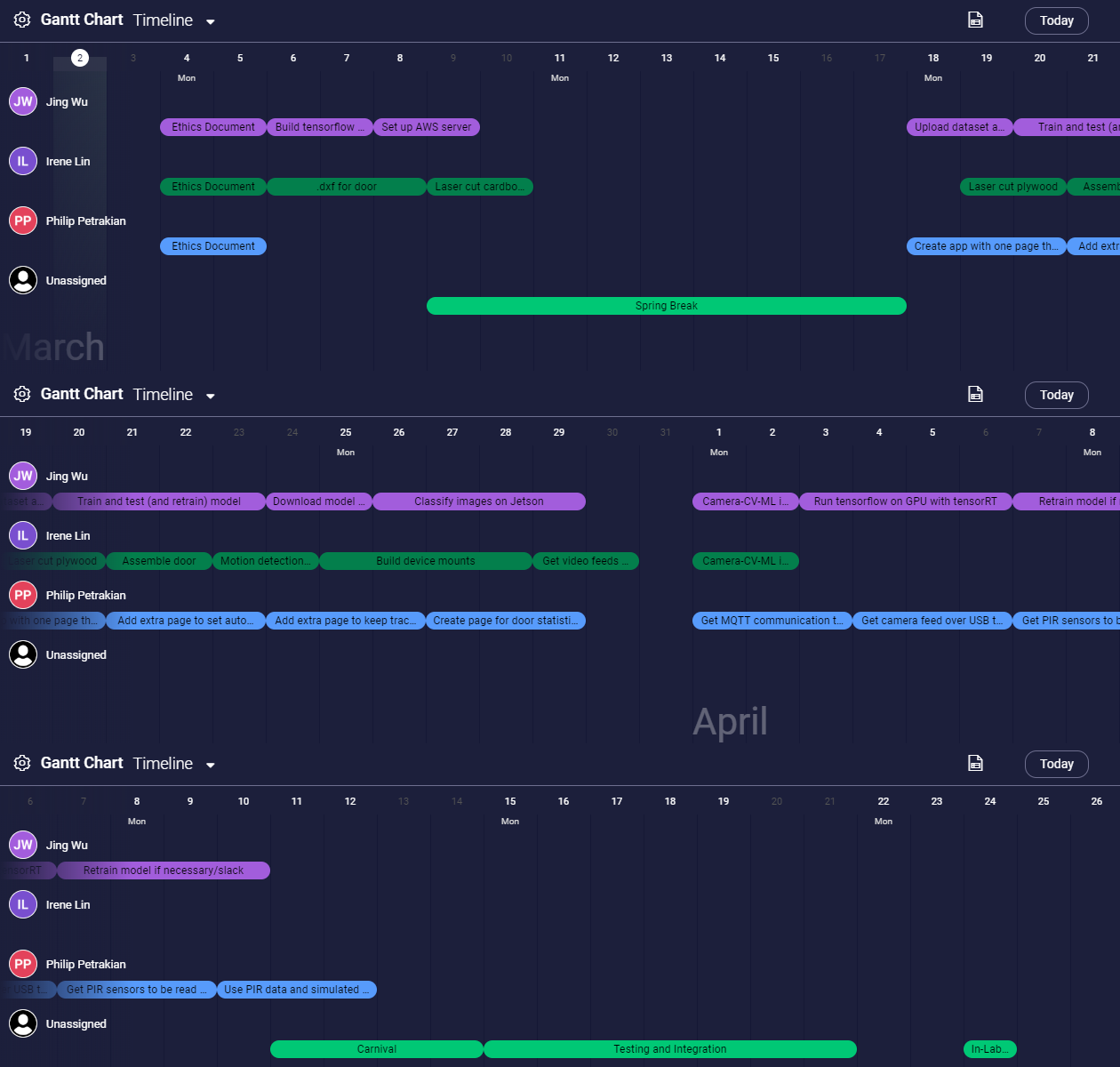We need to finalize the wiring and make sure the system consistently works as intended. These risks will be managed on Sunday by moving our system to another room and retesting the entire thing.
No changes to system requirements.
Carnegie Mellon ECE Capstone, Spring 2019 | Team A7: Jing Wu, Philip Petrakian, Irene Lin
We need to finalize the wiring and make sure the system consistently works as intended. These risks will be managed on Sunday by moving our system to another room and retesting the entire thing.
No changes to system requirements.
This week, the team finished the final presentation and worked together to finish integration and testing on the door. We finally found a solution to get the door to lift using a DC motor, a wheel, and wire. We should have a fully demo-able product by Monday. The door will be able to automatically lift when a cat is detected by the webcam, and the door will be able to be locked and unlocked by the phone app.
-The lifting mechanism for the door is an open feedback loop. Careful testing is required.
-We are concerned about not having enough time to do testing on the full system.
The servo is changed to a DC motor because neither the servo nor stepper motor would cooperate. The DC motor will share the 12V power supply with the solenoid. The motor was given to us for free because it was a spare part for a Build18 team.
We are worried about not having enough time to do testing on the full system. We have already cut away at unnecessary improvements such as optimizing the ML algorithm for the Jetson.
No changes.


Because our team decided that we would do integration in April, we have been focusing on individual parts for the in-lab demo on April 1. Irene will demo her Computer Vision algorithm, Jing will demo his Machine Learning inference, Philip will demo his iPhone app, as well as GPIO with the Jetson board.
Unfortunately, there are a few risks which have set us back.
The schedule is approximately the same as before, with a few extra tasks. Originally, by next Saturday April 6, we planned on doing the following tasks:
Irene: Integrate CV and ML
Philip: Get camera feed on Jetson
Jing: Run Tensorflow on GPU of Jetson
The tasks that we have added are:
Irene: Get stepper motor to work with the door
Jing: Build and test solenoid circuit

Philip not being able to completely finish his individual parts before April 1st. He will be focusing on getting the Jetson working and pause his current work on the app.
Jing not being able to achieve 95% accuracy rate for ML algorithm: look into changing the architecture to improve from the current 80%
Added a USB Hub to use with the Jetson. Otherwise, no changes to the design.

The current goal is to finish all individual parts by April 1st.
This week the team finished the design review report and spent most of the time working on individual parts, including the ethics reading assignment. Because it was the week before Spring Break, most of us were busy studying for exams or finishing large assignments due before break, however, we are still on schedule. We forwarded our design review report to Professor Bain for review and had a phone call with him to address some of the worries we had with scheduling. We agreed that everyone should plan on finishing every as early as possible to address unforeseen issues and communicate as soon as a problem arises, especially because certain parts depend on others. Although we weren’t planning on working over Spring Break, we will continue to make progress and keep each other updated during this time.
This week the team focused on finalizing the design presentation, as well as the design document. We spent a significant amount of time narrowing down our requirements, then finding solutions to accomplish these requirements. We initially struggled with finding a value for the false positive and false negative rates for the cat door opening. We were unable to find statistics on raccoon behavior, or a value for how much damage raccoons can cause. We then realized that our goal simply needs to be better than the current design of a regular cat door. For clear reasons, a regular cat door will always let a racoon in because there is no locking mechanism. Therefore, any value for false positive less than 100% would be an improvement. In addition, we decided to challenge ourselves to achieve a 5% false positive rate, as this rate is achieved by competent facial recognition algorithms. We also chose 5% as our false negative rate because if we assume a cat uses the door four times a day, the user would be alerted once over five days that their cat may be stuck outside, which is reasonable.
More on the project management side, we decided that in addition to our two meetings a week during class time and our Saturday meeting, we should meet most days for a “stand up.” These meetings will be done over Zoom and will allow us to communicate our accomplishments over the past 24 hours and what we wish to accomplish in the next 24 hours. We believe that this will help us work better as a team, as we will be staying in touch on a daily basis. This is especially important as the semester goes on, when we start implementing our designs.
Our team is currently on track!
